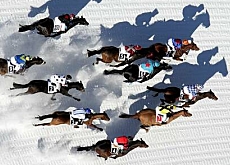
Swiss horses dominate White Turf

Switzerland enjoyed unprecedented success at the annual White Turf horseracing meet this year, winning all but one flat race on the frozen lake of St Moritz.
A Swiss was also crowned King of the Engadine after winning all three races in the centenary edition of the skijöring competition.
The unusual setting, 6,000 feet above sea level in canton Graubünden, is home to Switzerland’s only true international race meeting, attracting particular interest from around Europe
Top Swiss trainer Miroslav Weiss, who runs a stable in Urdorf, canton Zurich, hopes local success in this year’s White Turf can spur on further achievements on the continent and greater recognition for the sport in Switzerland.
“The quality of horses in Switzerland has been getting better and better in recent years,” he told swissinfo. “We are able to compete on more equal terms with other European countries, and my horses have won races in Italy, Germany and France in recent months.
“There are no real top quality racetracks in Switzerland and there is not enough land or interest here to build one. But Swiss horses are now making more of an impact in other countries.”
The Swiss also made a big impression during White Turf, which has been dominated in recent years by English, French and German stables. The only blip was a win for Belgian-owned Ianina in the showcase St Moritz Grand Prix on Sunday.
Street races
The international meet has come a long way since the residents of St Moritz a hundred years ago decided to don skis and race around the streets pulled by horses in an event called skijöring.
A year later, in 1907, skijöring moved onto the ice-covered lake to be joined by buggy and traditional horseback racing to start a festival of equine sport.
The event drew plenty of curiosity from outside Switzerland, but it was not until it took on the guise of White Turf in 1992 that the large sponsors and European stables turned it from a predominantly local attraction into the big money draw it is today.
Well over 30,000 spectators thronged to the three race days held on the first three Sundays of February this year, betting nearly SFr300,000 ($230,000) on the races. The combined purse for all races was SFr411,111.
The two-foot-thick ice provides a tricky surface for the horses, which have to wear special spiked shoes to avoid slipping. Horses train on sand in an effort to simulate the conditions.
Trainer Miroslav Weiss refused to reveal the secret of his training techniques that yielded five flat race victories and a clean sweep in the skijörking contest. But he admitted the unique conditions were hard on the horses.
“The surface is not very forgiving and I would not like to race my horses on ice all year round,” he said. “In addition, the thin atmosphere makes it more tiring for the horses than normal.”
Party atmosphere
White Turf still retains its unique party atmosphere amid the money and corporate interest.
“This is as much about the social atmosphere as about the racing,” said event spokeswoman, Barbara Keller.
And White Turf would certainly not be complete without the unusual spectacle of the skijöring races.
“It takes a special kind of skill and courage to be dragged around the track on skis by two fast horses,” said Keller. “With all the snow being kicked up in their faces, it makes the races the greatest snowball fight ever seen.”
The 100th anniversary of the first race in St Moritz was marked by celebrities such as mountain biker Thomas Frischknecht and showjumper Christina Liebherr racing with reindeer flown in specially from Sweden.
Proceeds from betting on the celebrity races, plus a franc from each entrance ticket sold and a SFr50,000 cheque from the two main sponsors, Credit Suisse and BMW, went to Swiss Sports Aid.
However, a fitting finale to White Turf 2006 was the crowning of Adrian von Gunten as the King of the Engadine, so named after the mountain region in which St Moritz is situated.
swissinfo, Matthew Allen in St Moritz
Of the nine flat races, eight were won by Swiss-trained horses. The exception was Belgian-trained Ianina, which won the star event, the St Moritz Grand Prix on the final Sunday.
Adrian von Gunten was crowned King of the Engadine after winning all three skijöring races in the centenary year of the competition.
Horseracing has been staged on the frozen lake of St Moritz for 99 years. The sport of skijöring celebrated its 100th anniversary in the region this year, having first taken place on the road between St Moritz and the village of Champfer in 1906.
Skijöring involves a person on skis being dragged behind a riderless horse around the 2,700-metre track at speeds of up to 50kmh.
The “turf” is a two-foot-thick layer of ice that forms the winter crust of St Moritz lake, situated at 6,000 feet above sea level in canton Graubünden.
This year’s event, spread over the first three Sundays of February, saw spectators bet a total of SFr288,075 on the races (compared with SFr305,472 in 2005).

In compliance with the JTI standards
More: SWI swissinfo.ch certified by the Journalism Trust Initiative





























You can find an overview of ongoing debates with our journalists here . Please join us!
If you want to start a conversation about a topic raised in this article or want to report factual errors, email us at english@swissinfo.ch.